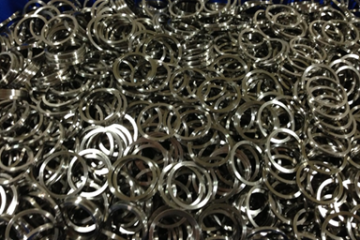Plating on Titanium
Plating on titanium parts adds value & functionality for many parts, especially aerospace parts and components.
Titanium is an extremely hard metal that can be used in a wide variety of applications. It has excellent corrosion resistance, high strength-to-weight ratio, low density, good thermal conductivity, and high electrical conductivity. Titanium is also highly resistant to abrasion and chemical attack.
Titanium is available in three alloys: Ti6Al4V (titanium alloy 6), Ti64 (a special grade of titanium alloy 64) and Ti46Al6V8. The first two are most commonly used, but the third one is more expensive.
The process of electroplating or galvanizing titanium involves immersing the part into a bath containing the electrolyte solution. A current is passed through the part, which causes the surface of the part to become coated with a thin layer of metal. This coating may be nickel, zinc, cadmium, tin, chromium, iron, copper, silver or gold.
The thickness of the coating depends on the amount of time the part is immersed in the bath, the voltage applied to the part, and the composition of the electrolyte solution.
Electrolytes used for electroplating titanium include sodium chloride, potassium chloride, ammonium chloride, calcium chloride, magnesium chloride, lithium chloride, boric acid, phosphoric acid, acetic acid, citric acid, hydrochloric acid, nitric acid, sulfuric acid, oxalic acid, and others.
Electroplated coatings provide protection from oxidation, corrosion, wear, and other environmental factors. They also add weight to the part, improving its performance.
Titanium parts are often plated using an automatic plating system. Automatic plating systems have been developed specifically for titanium parts because they require less maintenance than manual plating.
Galvanized Parts Galvanization is a process by which steel is protected against rust by applying a protective zinc coating. Zinc protects steel from corrosion by forming a barrier between the steel and oxygen in air. In addition, it forms a continuous film over the entire surface of the steel.
Galvanizing is done either manually or automatically. Manual galvanizing requires dipping the part into a molten zinc bath. This method is labor intensive and slow.
Automatic galvanizing machines use a conveyor belt to move the parts through a series of baths. Each bath contains different chemicals. The first bath removes oil and grease from the part. After this, the part is dipped into a second bath to remove any remaining oils and greases. Finally, the part is dipped in a third bath to apply the zinc coating.
Zinc is added to the final bath at a concentration level of about 15% to 20%. At these levels, the zinc does not affect the appearance of the part. However, higher concentrations of zinc will cause the part to turn black.
Zinc is added to the last bath in order to protect the part from corrosion. Corrosion occurs when the steel reacts with oxygen in the atmosphere. When the part is exposed to oxygen, the zinc acts as a barrier between the steel surface and the oxygen. As long as there is no contact between the zinc and the oxygen, the steel remains unaffected.
After the part has been fully coated with zinc, it is removed from the machine and allowed to dry. Drying takes several hours. During this period, the zinc coating dries and hardens. Once the part is completely dried, it is ready for further processing.
Galvanized parts are more durable than bare steel. They can withstand high temperatures without burning up. They are also stronger than uncoated steel.
